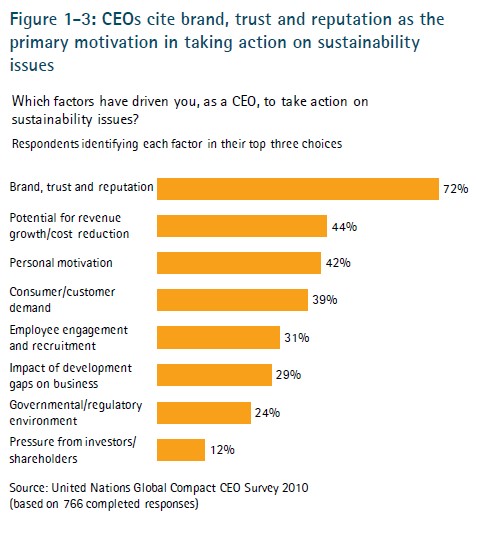When Does CSR Add Value to Brands?

When I started graduate school 10 years ago, corporate social responsibility, or CSR, was a lot newer than it is today. Certainly not unheard of, but only starting to become a big thing in the general public.
At that time, there was one thing I wanted to know immediately: Why do companies do CSR? Companies are presumably profit-motivated, but CSR is about generating social, rather than private benefits.

Propelled by this tension, my first project on CSR was a meta-study that collected and analyzed about two hundred surveys of companies on their CSR motivations. A main finding was that companies consider a top instrumental benefit of CSR to be branding. See Figure 1, for example.
It was this finding that motivated my second project: Does CSR, actually, improve brands? The result of this project is a study published this month in Business & Society, “Where, When, Who: Corporate Social Responsibility and Brand Value – A Global Panel Study.” My co-author was Jimi Kim of University of New South Wales, who infused energy into the project and shaped its thinking considerably.
As I conducted an initial literature review for the project several years ago, I discovered a large opening. Most existing research was on brand equity (the added value of a brand to product compared to a generic alternative?), with very little attention to brand value (how much can a brand itself be sold for?).
This seemed to be considerable gap. Brand equity is generally measured through consumer surveys, which are prone to social-desirability bias, as many consumers that claim to support CSR do not ultimately consider it at the cash register. Brand value, meanwhile, has the benefit of seeking to estimate the overall value of a brand in dollar terms as a company asset (rather than as an inscrutable scale that indexes consumer perceptions).
Having spotted an opening, I looked for data and fortunately happened upon the database of Brand Finance. This database was global, longitudinal, public, large, and unused. Many of these characteristics brought methodological benefits, such as the ability to include additional control variables, interaction terms, and statistical procedures to address endogeneity.
Motivating the first hypothesis in the ensuing paper was a feature of CSR’s evolution that I observed in my graduate-school years—CSR was going global. Nearly all previous studies on brand value, however, due to data limitations, had been focused on American companies. Thus, I saw an opportunity to test (and confirm) a “convergence theses,” that CSR can add value to brands in regions as far apart North America, Europe, and Asia.
Motivating the second hypothesis was an expected consequence of CSR’s deep diffusion and wide globalization. In such an environment, how could companies use CSR to stand out? Thus, the paper proposed and ultimately supported a “crowding out thesis,” that CSR’s branding benefits diminished with time in the years 2007-2013, as industries and nations were becoming saturated with CSR-practicing companies.
Motivating the third and final hypothesis was a problem not previously recognized in the literature but which I began to appreciate as I started working with the data. CSR and brands exist on different levels. CSR is a corporate-level construct, and corporations can own multiple brands. This led me to test and confirm an “identity-match thesis,” that CSR has a stronger effect on brands when consumers can readily link a corporation to its owned brands, for example, because they have highly similar names.
Overall, I hope that the paper, now published after many years of effort, brings new data on a question of great practical significance to business leaders, while drawing out and testing some major implications of the rapid global spread of CSR in recent years.






























































































